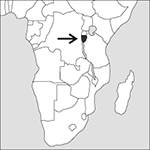
Capital:
Bujumbura
Area:
27,834 sq km (10,747 sq miles)
Population:
10,888,321 (2012 est)
Currency:
1 Burundi franc = 100 centimes
Religions:
Roman Catholic 61.4%; Protestant 21.4%
Ethnic Groups:
Hutu 85.0%; Tutsi 14.0%; Twa Pygmy 1.0%
Languages:
Rundi, French (both official); Swahili
International Organizations:
UN; AU; Non-Aligned Movement; WTO
A small landlocked country on the east side of Lake Tanganyika in east central Africa. It is bounded to the north by Rwanda, to the east and south by Tanzania and to the west by the Democratic Republic of Congo.
Physical
Burundi straddles the watershed of the Congo and the Nile rivers, while the Ruzizi River in the west flows along the Great Rift Valley.
Economy
Burundi’s economy depends heavily on foreign aid. The main exports are coffee and tea, with cotton and sugar as subsidiary exports. The biggest sector of employment is subsistence agriculture. There are large unexploited nickel deposits, and uranium, vanadium, and gold. Industry is limited. From the late 1980s until the 2000s the economy was disrupted by endemic ethnic violence and an acute refugee problem.
History
Burundi was ruled as a monarchy in the 19th century by Bami (kings) of the Tutsi tribe, who dominated a population of Hutu. Germany annexed it as part of German East Africa in the 1890s and from 1914 it was administered by Belgium, which obtained a League of Nations mandate and ruled it as a part of Ruanda-Urundi. In 1962 it became independent and in 1964 its union with Ruanda (now Rwanda) was dissolved. Burundi became a republic after a coup in 1966, but tribal rivalries and violence obstructed the evolution of central government. There were military coups in 1976 and 1987, and renewed ethnic violence in 1988 that left 5000 Hutu dead. In 1991 a referendum voted to restore the constitution with ‘democracy within the single party’. President Pierre Buyoya (a Tutsi) increased the Hutu membership of his Council of Ministers, but violence continued with many seeking refuge in Zaire and Rwanda. In 1992 a multiparty constitution was adopted. The first Hutu head of state, Melchior Ndadaye, was elected in 1993, along with a Hutu majority in the National Assembly, ending political dominance by the Tutsi. Tutsi army officers staged an unsuccessful coup six days after Ndadaye’s election, but in a second coup a few months later killed Ndadaye and many other Hutu politicians. The coup triggered fierce ethnic violence and massacres throughout Burundi and over a million refugees fled their homes, many going to neighbouring countries. Ndadaye’s successor, another Hutu, was killed in a plane crash in 1994. Violence and instability continued, with ethnic killings reaching an average of 1,000 a month in 1996. In July of that year a Tutsi-led military coup ousted President Sylvestre Ntibantunganya and installed Pierre Buyoya in his place. A power-sharing agreement in 2001 gradually restored stability, and a new constitution in 2005 paved the way for the peaceful election of Pierre Nkurunziza as President later that year. Difficulties remain, however: all opposition parties boycotted the 2010 presidential and legislative elections, which resulted in Nkurunziza’s unopposed re-election; and some rebel groups remain active. After an attempted coup, Nkurunziza was re-elected for a third term in the July 2015 presidential election, despite protests that his candidacy was unconstitutional. The UN Security Council condemned the violence both before and after the election which has killed over 500 people and forced over 250,000 to flee the country. The May 2020 election was won by Gen Évariste Ndayishimiye (with Nkurunziza dying unexpectedly in June).
- l-form
- LGA
- LH
- LHA
- LHB
- LHC
- lherzolite
- LHS
- LHS scheme
- L'Hôpital, Marquis Guillaume François Antoine de
- li
- liabilities
- liability
- Liang–Barsky clipping
- Liao (945–1125)
- Liaqat Ali Khan, Nawabzada (1895–1951)
- Liar paradox
- liar paradox
- Lias
- Libby, Willard Frank
- Libby, Willard Frank (1908–80)
- libeccio
- Liberal Democratic Party((Japan))
- Liberal Democrats
- liberalism